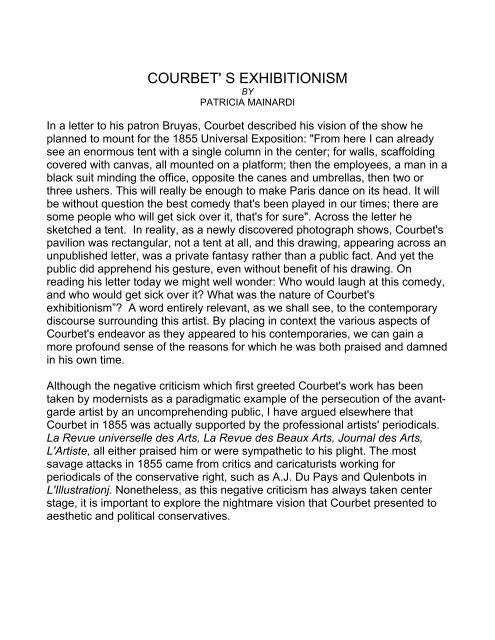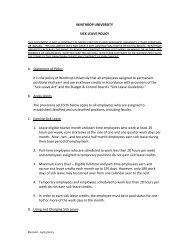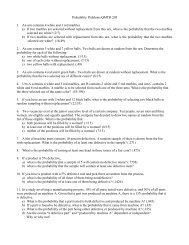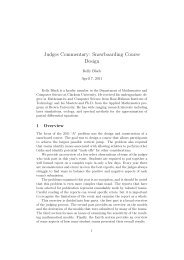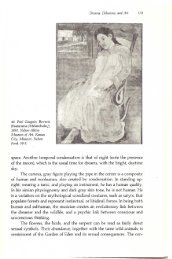COURBET' S EXHIBITIONISM
COURBET' S EXHIBITIONISM
COURBET' S EXHIBITIONISM
- No tags were found...
Create successful ePaper yourself
Turn your PDF publications into a flip-book with our unique Google optimized e-Paper software.
<strong>COURBET'</strong> S <strong>EXHIBITIONISM</strong>BYPATRICIA MAINARDIIn a letter to his patron Bruyas, Courbet described his vision of the show heplanned to mount for the 1855 Universal Exposition: "From here I can alreadysee an enormous tent with a single column in the center; for walls, scaffoldingcovered with canvas, all mounted on a platform; then the employees, a man in ablack suit minding the office, opposite the canes and umbrellas, then two orthree ushers. This will really be enough to make Paris dance on its head. It willbe without question the best comedy that's been played in our times; there aresome people who will get sick over it, that's for sure". Across the letter hesketched a tent. In reality, as a newly discovered photograph shows, Courbet'spavilion was rectangular, not a tent at all, and this drawing, appearing across anunpublished letter, was a private fantasy rather than a public fact. And yet thepublic did apprehend his gesture, even without benefit of his drawing. Onreading his letter today we might well wonder: Who would laugh at this comedy,and who would get sick over it? What was the nature of Courbet'sexhibitionism”? A word entirely relevant, as we shall see, to the contemporarydiscourse surrounding this artist. By placing in context the various aspects ofCourbet's endeavor as they appeared to his contemporaries, we can gain amore profound sense of the reasons for which he was both praised and damnedin his own time.Although the negative criticism which first greeted Courbet's work has beentaken by modernists as a paradigmatic example of the persecution of the avantgardeartist by an uncomprehending public, I have argued elsewhere thatCourbet in 1855 was actually supported by the professional artists' periodicals.La Revue universelle des Arts, La Revue des Beaux Arts, Journal des Arts,L'Artiste, all either praised him or were sympathetic to his plight. The mostsavage attacks in 1855 came from critics and caricaturists working forperiodicals of the conservative right, such as A.J. Du Pays and Qulenbots inL'Illustrationj. Nonetheless, as this negative criticism has always taken centerstage, it is important to explore the nightmare vision that Courbet presented toaesthetic and political conservatives.
Today we focus on Courbet's gesture of mounting his show and we see it as agesture of defiance to the government that had rejected both his Studio and hisBurial. Indeed it was, as Champfleury wrote at the time, "an incrediblyaudacious act". Our focus on the gesture fits in well with modem politicalimperatives, the heroiization of the individual standing alone against an unjust
state. The issues embodied in Courbet's gesture, Individualism, Selfconfidence,Defiance, Genius, are all qualities, which define the modern -usually male - hero. They are also, however, qualities which define the selfmademan of early capitalism, the entrepreneur.This latter referent has been largely ignored by art historians, but bothinterpretations, defiant hero and entrepreneur, should be explored, for in thenineteenth century, they were by no means mutually exclusive.To begin to see Courbet's exhibitionism as his contemporaries’ would haveseen it, we will have to understand first the exhibition structure as they saw it,second, traditional exhibition sites as they understood them, and third, thedecorum of exhibitions at that time, for Courbet's gesture could only assumemeaning against the commonly accepted fabric of expectations and procedures.In giving the broad outlines of these issues, it must be stressed that, although Iam here focusing on the negative contemporary opinion held various attitudes,both positive and negative, towards each.Throughout most of the nineteenth century, the major event in French exhibitionpractice was the Salon, the annual, sometimes biennial exhibition ofcontemporary art. Until the 1789 Revolution, it had operated as a monopoly,controlling French artistic life and careers. Only members Of the Academy couldparticipate and alternative exhibitions were suppressed. The Academy hadbeen founded and was maintained as the Government agency in charge ofaesthetics: its members received salaries and studios, and State commissionswere originally reserved for them. Academicians had, however, elevated theirstatus from that of artisans by rejecting all hints of commerce and so, in theAcademic Salon of the Old Regime, artists did not exhibit works for sale but"consented to show to a limited public some pictures commissioned in advancefor a specific destination”. Although in reality many Academicians worked in avariety of modes, this elite attitude towards art production survived well into thenineteenth century, defining one pole of the spectrum of attitudes towardsexhibition practice. That pole can be summed up in the word exposition; in bothEnglish and French it preserved the connotation of a didactic, morally instructiveshow. The word exhibition, on the other hand, while meaning in English simply ashow, assumed in nineteenth century France a pejorative connotation ofostentation and immodesty. A commercial enterprise, such as a shop windowdisplay, would be an exhibition, as would personal behavior we today wouldlabel exhibitionist . This negative attitude towards anything commercial derivedfrom traditional aristocratic disdain for cornmerce, which, in the nineteenth
house. Through this politico-aesthetic language, of bazaars and picture shops,of mediocrity and aristocracy, a political system (democracy) and an economicsystem (capitalism) - was being criticized. Courbet, through his 1855 show,symbolized both institutions. It is clear that in 1855, the two poles of the Salonwere; on the right, elevated, academic exhibition as close as possible tot theideals of history painting and the Ancient Regime. On the left there was thepopular Salon, full of independent artists striving to appeal to the public in orderto sell their work. But if, in fact, the other pole from the aristocratic closed pre-Revolutionary Salon was to be the open, somewhat democratic andindependent Salon, where does that place Courbet's pavilion? Whenconservatives referred to a bazaar, they were both exaggerating and speakingmetaphorically. Courbet intentionally produced the very image of theirnightmare, but not the quaint, sentimentalizing imagery of a bygone epoch, ofmarche and bazaar, but in the contemporary worId of burgeoning mass cultureand commercialism – the art exhibition as store.To place Courbet's 1855 show, we must understand how rare any individualshows were in France. The most common examples of these events were theposthumous shows organized for recently deceased Academicians and held inprestigious locations such as the École Normale Supérieure itself. Galleries atthis time were still picture shops displaying and selling a variety of work by avariety of artists. Artists occasionally held their own shows in their studios, asDavid did in 1799 and Horace Vernet in 1822, but, by being held in their studios,these shows preserved the dignity of high art events, even when they wereintended as protest. Courbet's 1855 show has always been identified with thistradition, a protest against the Exposition Jury's refusal of his two majorpictures, The Artist's Studio and A Burial at Ornans. And yet even before hesubmitted his pictures to the Jury' he had informed Nieuwerkerke, the Intendantdes Beaux-Arts, that he was hoping to mount a private exhibition to competewith the Universal Exposition, and he had dropped several hints to his patronAlfred Bruyas that such a show (which he wanted Bruyas to subsidize) was inthe offing. One could argue that he anticipated that his pictures would berejected, but it must also be acknowledged that he very much wanted, from thebeginning, to hold this show and to hold it on a site identified with thedistribution of art and not its production. in other words, to hold it as acommercial enterprise. Indeed he had already made two previous attempts inthis direction in 1850; in Besancon and in Dijon, the first in a market hall, thesecond in a house that also held a cafe. In both cases he had plastered thetown with posters advertising his show and had charged a fifty-centimeadmission fee. Riat quotes him as feeling that the peasantry of Ornans had
thought he was an idiot because he had let them see his works for free, "whichevidently proves it's silly to have a kind heart, for it merely deprives one of fundswithout enriching others in spirit or purse. To be free, people want to pay, sothat their judgment won't be hayed by gratitude. They are right. I want to learnand I'll be so ruthless that I'll give everyone the right tell me the most crueltruths".This leads to my second point, the issue of a suitable location for art exhibitions.The annual Salon took place in the Louvre until 1848 when, evicted from themuseum, it began a nomadic existence. Pressure had begun to mount in the1830s to evict it from the Louvre, mostly coming from conservatives who feltthat art, which increasingly rejected tradition, had no right to partake of theelevated provenance associated with that museum. The Salons of 1849, 1850-1852, were held in the Tuileries Palace and in the Palais-Royal. 1853 presentedartists with the worst disappointment of all, for that year's Salon was held intemporary buildings surrounding the Imperial furniture warehouse at Menus-Plaisirs in northern Paris. During these years there was continual talk ofsuppressing the Salon altogether; Ingres ad actually recommended such acourse when he testified before the 1848 Commission Permanente des ieaux-Arts: "In order to remedy this overflow of mediocrities, which has resulted inthere no longer being a French School, this banality which is a publicmisfortune, which afflicts taste, and which overwhelms he administration whoseresources it absorbs to no avail, it would be necessary to give up expositions..."Rumors and uncertainty ran rife through the artists' community. Would therecontinue to be a Salon? If so, where would it be held? The very future ofcontemporary art seemed to be at stake during these years, so Courbet'scarnival tent would not seem very funny to those who feared that contemporaryart might end up exactly there.Art galleries as we know them were still in their infancy in the first half of thecentury. In 1843 the critic. Louis Peisse wrote: "Outside the Louvre there wouldno longer be a Salon, there would be only picture, hops". Galleries were thenindeed picture shops selling, indiscriminately, art supplies, curios, and smallpictures from the lower categories of art - genre, landscape, and still life. Thecommon conservative complaint that the Salon had become a bazaar or apicture shop showed that, in fact, these institutions were seen as the onlyalternative to the museum. So the two poles on he exhibition spectrum were theLouvre, for expositions of educational, historical art, and the picture shop forexhibitions of commercially viable, decorative art. And yet art dealers at thistime were not interested in bold entrepreneurial initiatives, such as the
promotion and marketing of a trademarked product, namely the one-artist show.Courbet, then, with his one-artist show, was an innovator of marketingtechniques for art in the early capitalist period. In several letters to Buras,Courbet bragged about how profitable this show would be: "I'll gain 100,000francs in one shot", he wrote, and later "I'll be considered a monster but by allpredictions I'll make 100,000 francs". He'll sell his livret (pamphlet) he writes.He'll make money on checking canes and umbrellas. He's even havingphotographs of his paintings made so that he can sell those too. I think weshould listen to him, for only then can we see both what he intended by hisgesture, and what his conservative contemporaries loathed about it: Courbetwas the new self-made man. Nineteenth century France had many such: Benin,who founded Le Journal des debates, in France. It was only because of David'sgreat celebrity, and the extreme curiosity that his work aroused, that the publicaccepted a practice that is repugnant to all our French customs. Although thismode of exposition succeeded in that David earned 20,000 francs, he washarshly criticized, and ever since no artist has dared try it again". In the heatedpolemics accompanying the introduction of admission fees at the 1855Universal Exposition, the standard objection was to stress that, under thelongstanding policy of “noblesse oblige”, a benevolent state owed to its citizensfree access to those institutions considered spiritually and morally uplifting, suchas churches, schools, libraries, public monuments, and expositions. Chargingadmission fees, it was feared, would lower art exhibitions to the level of popularentertainment, like theatres. Courbet, however, blatantly moved art into thissphere of commercial entertainment and self-promotion, with his pavilionadvertising his own name “G. Courbet”, as prominently as did the bold redsignatures on his paintings. Charles Perrier, the critic for L'Artiste, commented“everyone has seen Monsieur Courbet's poster with its huge lettering plasteredover the walls of Paris, next to street performers and quack doctors, inviting thepublic to come and pay a franc to see his exhibition of forty pictures of his ownwork. Bertall's cartoon "At the end of the Universal Exposition, Courbet! awardshimself some well-merited honors", criticizes the artist both for commercialism(the receipt box is prominently displayed) and for immodesty (he is awardinghimself a laurel wreath). The critic Ernest Gebauer attacked Courbet in 1855thus: "M. Courbet, not satisfied with having eleven pictures in the UniversalExposition, indulged himself by setting up his own special exhibition a few stepsfrom Palais des Beaux-Arts". In other words Courbet's show manifested therequisite commercialism, ostentation, and immodesty, which defined it as anexhibition.
In addition to the commerce of the picture shop, Courbet's 1855 show alsorecalled the outdoor fairs, the immediate predecessors of the resolutely noncommercial,dignified Salon exhibitions. These lowly antecedents to the Saloncontinued to be an unwelcome memory of the past in the collective memory ofAcademicians and conservatives in general; hence their criticism of the Salonas a bazaar. Joined to this, however, was an even more frightening spectre ofthe future: the commercialization and commoditization of art that, they feared,would happen under capitalism. In other words, to conservatives Courbet'sshow represented the worst of both the old and the new systems of artdistribution. For us today it is less shocking and more laudable to see Courbetraging against an unjust State than to see him making a crassly commercialgesture. But to nineteenth century conservatives, it was the disturbingcommercialism of his gesture rather than its political content that was shocking.After all, in 1855 the political opposition came from both left and right; with therepeated revolutions and counter-revolutions which had shaken France since1789, almost everyone had had a taste of being in the political opposition atsome time.II. Courbet's Exhibitionism as CarnivalAlthough I have been reading Courbet's exhibitionism as a function of capitalismand the new economic and social order, this should be underscored by asecond level of interpretation which compounds the first: Courbet'sexhibitionism as carnival. If the Louvre, the Palace of Kings, represented thearistocratic tradition, and the Palace of Industry at the Universal Expositionrepresented the challenge launched by capitalism, then Courbet's pavilion canbe seen as disruptive of both orders. Carnival, of course, did exactly that.Carnival, the period from Twelfth Night (6 January) to Ash Wednesday of eachyear, culminating in the revelry of Mardi Gras, celebrated the world-upsidedown,the reversal of the normal order of events. It was filled with feasting anddrunkenness, dancing and orgies, masquerades and street theatre. Inversionwas its basic premise, satire and parody its means: the lowly were raised upand the mighty were abased; social, political, and moral order could be safelytransgressed. Carnival during the 1830s and 40s had become increasinglypolitical; no one had forgotten that the February Revolution of' 1848 had takenplace during Carnival and that the two events had been intertwined in agrotesquely surrealist spectacle: carnival processions turned into mob riots,
carnival floats into insurrectionary wagons. Napoleon III had certainly notforgotten and his 1855 Universal Exposition, far from having a carnivalesqueatmosphere, must be seen as the very antithesis of that, rigidly controlled andorganized. This fact is important in order to understand the contrast presentedby Courbet's pavilion. At the very entrance to that Exposition, it fulfilled thecarnivalesque function of deflating the pretentiousness of the mighty. And hisgesture was indeed understood: Le Figaro described Courbet's pavilion, facingthe Palais des Beaux-Arts of the Universal Exposition, as "Guignol's theatrenext to La Scala of Milan.., that is, the Punch and Judy show, a satirical andsubversive institution of popular culture, juxtaposed to its antithesis, the high artopera house.Ever since Meyer Shapiro's brilliant article of 1941, "Courbet's PopularImagery", we have been aware of the relationship between Courbet's art andpopular images. I would like to take that a step further and propose thatCourbet's interest was not just in a generalized popular culture of Epinal printsand the customs of the rural bourgeoisie, but, with his instinct for the "mostcomplete expression of a real thing", Courbet focused on the most subversiveand threatening aspect of popular culture, and the only one that had bothpolitical over- tones and a revolutionary history, namely carnival.The political carnivalesque informs Courbet's 1855 show. When Courbet wrotethat his show "will really be enough to make Paris dance on its head", hisstatement conflated the two major features of carnival, revelry with the image ofthe world-upside-down. The fear that Champfleury described as theconservative response to Courbet's show ("It's a scandal, it's anarchy, it's artdragged through the mud, it's a fairground spectacle") was identical to their fearof carnival when all social order was transgressed. Taxile Delord, in LeCharivari described Courbet as a carnival barker shouting to artists to follow hisexample and abandon official expositions. Gavarni drew just such an image ofthis popular carnival type as the introductory plate of "Les Debardeurs".Daniel Stern (Marie d'Agoult) published an account of the invasion of theTuileries in February 1848 that gives the flavor of Carnival/Revolution wheremasquerade and parody combine. Daumier's cartoon of the Paris gamin (streeturchin) on the throne is based on this incident. She wrote: "The children dressthemselves up in velvet robes, turn the golden drapery fringe into belts, andpieces of tapestry into Phrygian caps. The women pour over their hair theperfume that they find on the princesses' tables. They rouge their cheeks, covertheir shoulders with lace and furs and decorate their heads with sprays of jewels
and flowers. They deck themselves out with a kind of burlesque taste parodyingextravagant dress". Compare this to Courbet's Young Ladies of the Village,criticized by Du Pays in L'illustration as "the most anti-picturesque, the mostunpleasant thing in the world: the pretention to elegance flaunted by thecommon people". Even in conservative critics' frequent attacks on Courbet asthe "apostle of ugliness", one can read the world-upside-down, for ugliness wasthe reversal of beauty, which to conservatives was the proper sphere of art.Young Ladies of the Village, Salon 1852I am proposing that, if we look at Courbet in the light of carnival, we can betterunderstand the hysteria his works provoked in conservative circles. Parody andinversion assume a new and sinister dimension in the raucous Return from theConference featuring drunken priests, or the oversized Beggar's Alms that thecritic Chesneau claimed represented France. Courbet constantly reversed thetraditional hierarchical relationship of pictorial category to size. in paintingssuch as The Stonebreakers, The Grain Sifters, After Dinner at Ornans, ordinarypeople are elevated to a size and status traditionally reserved for gods and
heroes. Parody and inversion proved more subtle, though equally disturbing,in A Burial at Ornans, whose enter is the void of death, and whose red-nosedbeadles seem to mock the solemnity of the event.Return from the Conference, 1862, Destroyed
Beggars Alms, 1868. Glasgow Museums and Art Galleries.A Burial at Ornans, 1849. Paris, Music d'OrsayIn the light of Klaus Herding's reading of The Artist's Studio as an adhortatio adprincipem, the traditional exportation to the ruler, Linda Nochlin has recently
suggested that we might also read this as world upside-down, with the "normal"order of the world reversed: the monarch must now listen and learn, while theartist wants the benefit of his example to the ruler.The Artist’s Studio, A Real Allegory of a Seven Year Phase in my Artistic (and Moral) Life,1855Carnival existed at mid-century as a constellation of attitudes and modes ofbehavior. Courbet knew just how to exploit, under the guise of humor, the threatthat carnival still contained. He created works that, like time bombs, wouldexplode in politically and aesthetically conservative circles.To his conservative audience, Courbet's 1855 show was certainly an exhibition.He travestied every aspect of high art practice, ostentatiously and immodestly,and did so with publicly avowed commercial intent. His contemporaries sawCourbet the carnival barker presiding over a disturbing vision of the worldupside-down,parodying the high, the mighty and the respectable; at the sametime, they saw the spectre he presented of the “future of art'', in the capitalistcommodity system. For to true nineteenth century conservatives, the coming ofthe new bourgeois economic and social order was the world upside-down. Whatlooks like a contradiction to us today was, in fact, a single nightmare vision in1855; the defiant hero and the entrepreneur.P.M.


